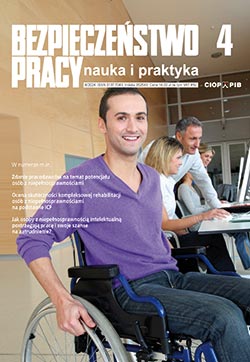Classification of the model safety clothing composition equipped with direct light sources
Krzysztof Łężak
The standard high visibility clothing previous used in the professional and non-professional practice, in the absence of directional lighting does not ensure the visibility of its user. A factor that can improve the protective properties of warning clothing may be the retrofitting it with elements that emit direct visible radiation. The clothing with various types of active light sources have started to appear on the market for several years, but so far there are no the standardized test methods and the requirements for this type of clothing. In order to create the possibility of assessing such clothing, we conducted the photometric and functional tests of model high visibility clothing solutions with the application of lighting elements. On the basis of the results obtained and their analysis, a basic classification of this type of clothing was proposed in terms of the minimum luminance requirements of the light emitted from it, as well as criteria for its assessment.
Evaluation of the efficiveness of reflective accessories in conditions of the actual use – results of the original study
Adam Pościk
The article presents the results of the study on the photometric properties for selected reflective accessories, conducted with the use of the standard method described in PN-EN 13356: 2004 as well as the method used in simulating realistic condition of the use of reflective accessories. For this purpose the standard goniometer was replaced by a half-mannequin. Results of the study were used to verify the effectiveness of visibility of reflective accessories in conditions simulating their actual use after having them attached to clothing. The article also discusses limitations of the use of these accessories, recommendations regarding the minimum area of their attachment and ways of their proper attachment to clothing in order to achieve adequate visibility.
Assessment of the position of the wearable device based on the radio signal strength in the sensor network for monitoring hazards in work environment
Leszek Morzyński , Grzegorz Szczepański
Concentrations and intensities of harmful factors in the work environment must be tested and assessed for hazards caused to employees. In conditions of changing parameters of the working environment, detection of potential threats and quick action to reduce employee exposure is possible based on the continuous monitoring of working environment parameters. Wireless sensor networks can be used for this purpose. The article discusses the structure and main issues of the sensor network being developed at CIOP-PIB to monitor the work environment and warn employees about hazards. The method used to locate the warned employee within the sensor network was presented, as well as the results of radio signal strength measurements, on which this method works.
How to help? – an adaptive support program for vocational reintegration for people with disabilities and the elderly
Andrzej Najmiec
The paper describes types, assumptions and forms of help of support’s programs in purpose of vocational reintegration. Attention is paid to various forms of help conditioned by the phase of dealing with loss of efficency. The cooperation of various supporting specialists requires an unified and exhaustive classification system – the International classification of functioning, disability and health (ICF). The role and attitude of psychologists are important in the process of adaptive support. There is a model of an exhaustive assessment of work capacity developed in CIOP-PIB.




























